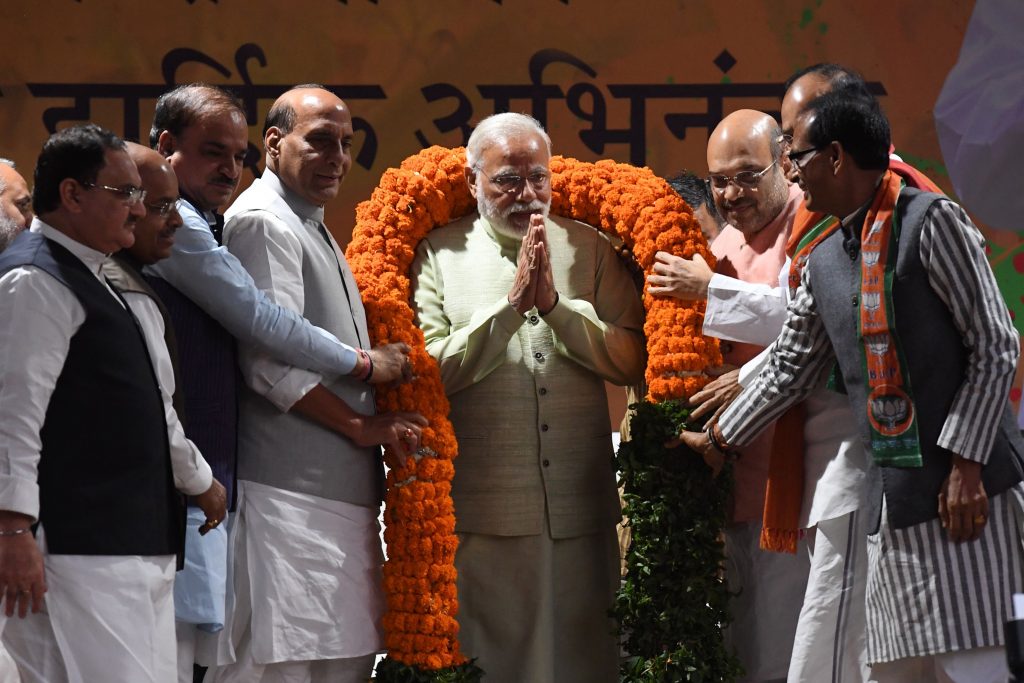By Allison Fedirka
State legislative election results in India are in. Local and international media are calling the victory by Prime Minister Narendra Modi’s Bharatiya Janata Party (BJP) in Uttar Pradesh state a monumental success. This event confirms our previous assessment that questioned the negative political impact of demonetization in India and raises questions over Modi’s ability to increase the central government’s power and assert control over the country. Our 2017 forecast asserts that Modi will ultimately fail in this endeavor. The election results do not disprove the forecast, but they do raise the question of whether this is an early indicator of Modi’s ability to consolidate power.
State legislative elections in India are important for two reasons. The first is the degree of influence state institutions have on the federal government. Each state’s legislative assembly indirectly votes for its representative in India’s upper house of parliament, the Rajya Sabha. State governments selected 233 of the 245 members currently serving in the upper house; the remaining 12 are presidential appointments. The second reason is India’s administrative power structure. Given the vast size and diversity of India’s population, much of the governing was legally designed to be carried out by individual states or union territories. Each state has a chief minister, who occupies the main office holding and executing power at the state level. This office goes to the leader of the majority group in the state’s legislative assembly. In other words, the party that runs the state legislature also selects from its ranks the most powerful state-level political officer.
Indian Prime Minister Narendra Modi, center, is greeted on stage at Bharatiya Janata Party headquarters where he delivered a victory speech in New Delhi on March 12, 2017, a day after votes were counted in legislative assembly elections in five Indian states. PRAKASH SINGH/AFP/Getty Images
Not all states are created equal, and this explains the media hype over BJP’s victory in Uttar Pradesh. The excessive attention given to Uttar Pradesh stems from its position as the most populous state in India, with over 200 million inhabitants. Historically, it has been a bastion for non-BJP opposition parties. However, this is not the first time the BJP has dominated polls in Uttar Pradesh. In 2014 elections, when Modi was voted into power, the BJP won 73 of Uttar Pradesh’s 80 seats in the national parliament’s lower house. The BJP’s continued success does not disprove our forecast, but it does mean we will now be reviewing the elections within the framework of our model and forecast.
When looking at results from all five states, the overall performance of Modi’s BJP is positive, but not to the point of guaranteeing single-party rule in India. The BJP decisively won in Uttar Pradesh with 312 of 403 state legislature seats, and in the northern state of Uttarakhand with 57 of 70 seats. Both states are particularly noteworthy because BJP took control of state legislatures from regional opposition parties. Results show that regional parties have been gutted in these two states, which national parties have not controlled for decades. A national party last ruled Uttar Pradesh in the 1980s, when the Indian National Congress (INC) dominated the country’s politics and came the closest to one-party rule.
These two state legislative assemblies also have a strong enough majority to select pro-government Rajya Sabha members when new terms are due. Uttar Pradesh sends 31 members to the Rajya Sabha, of which three currently belong to the BJP. The next round of term selections will take place in April 2018, with 10 seats to be filled (one currently is held by the BJP). Uttarakhand is much smaller, occupying only three seats in the Rajya Sabha. The BJP holds none of these seats, although one also will open in April 2018.
Modi’s party is vying to lead a coalition for control of state legislatures in Goa and Manipur. The BJP claims to have a large enough coalition to form governments in both states. The BJP won 13 of 40 seats in Goa’s state legislature, the INC won 17, the regional Maharashtrawadi Gomantak Party (MGP) won three, and seven were registered as independents or “other.” Goa’s governor already had invited BJP leader and former Defense Minister Manohar Parrikar to form a coalition government. While that BJP-led coalition remains in power, BJP lost eight seats compared to 2012 legislative elections, while MGP lost four. The INC, on the other hand, gained eight seats. The BJP’s hold on Goa state is much more tenuous now compared to five years ago.
In Manipur, BJP won 21 of 60 seats, while INC won 27. Regional party All India Trinamool Congress won one, and 10 were categorized as independent or “other.” Manipur’s governor has asked the current chief minister to resign to hasten the formation of a new government. Similar to Uttar Pradesh, Manipur saw a notable decline in regional parties winning seats. Given that BJP did not hold seats from 2012 elections, winning a third of the seats is a notable accomplishment. In addition, through a coalition, the BJP has the potential to take state legislative power away from the opposition INC. Both Goa and Manipur are small states in terms of representation in the Rajya Sabha, with one seat for each state. While an argument could be made that Goa’s wealth makes it more relevant to the national economy, it remains secondary to economic powerhouse cities like New Delhi and Mumbai.
In Punjab state, the BJP has virtually no power. Modi’s party won only three seats out of 117 in the state’s legislature. Instead, the main opposition party, INC, firmly controls the state legislature with 77 seats. These results do not come as a surprise, as polls and political analysts anticipated a strong performance in Punjab. Previously, a legislative coalition led by the regional Sikh party Shiromani Akali Dal (SAD) and adhered to by BJP controlled the state’s assembly. The BJP lost ground in these elections, and again we see a nationalist party, in this case the INC, assuming more power in a state that was previously dominated by regional political parties. Punjab contributes seven members to the Rajya Sabha, and all of their terms extend to 2022. Of these seats, the BJP and INC hold three, and SAD one.
These election results tell us that Modi faced relatively little political backlash from his November 2016 decision to demonetize high-value currency bills. In other words, the BJP’s calculation that the drive would not hurt the party proved correct. Geopolitical Futures asserted that there was a method behind Modi’s supposed madness and that he was operating on short-term costs for longer-term gains. These were the first elections since demonetization measures four months ago. Some of the people most affected by these measures belong to the lower economic classes and work primarily in the informal economy, operating almost exclusively with cash. Uttar Pradesh is one of the poorest states in India, but it voted for Modi as people bought into anti-corruption efforts and the promise of a better economy in the future. Not only has Modi maintained voter favor, but also the economy has started to normalize. New currency has entered the system (although it’s not yet fully restored to pre-demonetization levels), ATM restrictions have been lifted, and growth for this year was only lowered by tenths of a percent and is still projected to reach 7 percent.
Power consolidation takes place over time, and in this sense, the state elections that occur each year in India serve as data points for deciphering political trends and trajectories. On the one hand, Modi’s monetary policy clearly affected a vast swath of the population in Uttar Pradesh but failed to hurt his popularity. This is evidence that Modi may be far more effective at centralizing power within India than previously thought. On the other hand, general elections for the lower house of parliament take place in 2019, when Modi could lose more ground in places like Punjab state. Additionally, while some Rajya Sabha members will be selected in 2018, Indian political analysts assert that it will not be until 2020 when the BJP can really cash in on state legislative wins and consolidate its hold over the upper house. At this point, what we can take away is that two national powers – BJP and INC – are now contesting and winning space in state legislative assemblies that previously saw much stronger participation of regional political parties. This raises the question of whether Modi and the BJP will be able to overcome the diversity in the national electorate and party base to garner enough power to successfully achieve single-party rule and implementation of his ambitious economic reforms.








